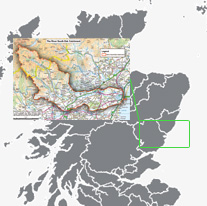River Engineering
In the past river engineering in the area has been carried out for a number of purposes including:
- To stabilise the banks to prevent erosion and loss of agricultural land;
- To create canals to move flood waters away from areas of flooding;
- To install river bed engineering to improve fisheries;
- To create weirs to divert water for mills and to reclaim land for building houses on;
- To build groynes (low walls) to prevent waves wearing away land;
- To carry out dredging to allow ships into Montrose Harbour;
- To build embankments to protect houses built on floodplains; and
- To dig out gravel to maintain fishing pools.
 Drainage activities when managing land use such as moorland, forestry and agriculture are also ongoing in the area. And, all of these are difficult to regulate. The main method of regulation is the Environmental Impact Assessment (EIA) regulations for forestry and agriculture.
Drainage activities when managing land use such as moorland, forestry and agriculture are also ongoing in the area. And, all of these are difficult to regulate. The main method of regulation is the Environmental Impact Assessment (EIA) regulations for forestry and agriculture.
While some engineering activities do have a continuing role to play in managing rivers, many have lead to changes in the natural processes which happen in the river system. These, in turn affect the wildlife that the river can support, while not always producing the desired solutions.
All engineering work close to or on a river is now licensed by SEPA under new regulations – the Controlled Activities Regulations (CAR) April 2006, as part of the Water Framework Directive. The following are some examples where river engineering has been carried out in the area in the past.
Upper catchment – The Burn of Heughs (Rottal Burn) and the March Burn in the upper catchment are examples of burns, which have been straightened to try and prevent flooding of nearby agricultural land, although there are many other burns which have been engineered.
Middle catchment – The Noran water which has Glenogil reservoir and the Den of Ogil reservoir, both man-made structures designed to act as backup public water supplies. The river South Esk has had gravel extracted and has a number of weirs along it. The Lemno Burn has also been straightened.
Lower catchment - Many burns have been straightened across the area, with the Pow Burn being the largest. Parts of Montrose Basin have been reclaimed for development and are defended with gabions (wire baskets filled with earth and stones). The South Esk Estuary is routinely dredged and the coast is protected at the estuary mouth using groynes and gabions.


